Dogs can suffer from a variety of different problems that could rob them of their mobility. Although this is admittedly tragic, you don’t want to sit around feeling sorry for your pooch. Instead, you’ll want to get busy finding a solution.
The easiest way to restore your dog’s mobility is to purchase a commercially manufactured wheelchair (check out our canine wheelchair buying guide for some suggestions). However, these types of wheelchairs aren’t exactly cheap and can be a bit difficult for some owners to afford.
Fortunately, there are a number of different ways you can build your dog his own wheelchair. Doing so will often take a bit of patience as well as a healthy dose of trial and error, but it’ll usually save you a ton of money in the process.
We’ll share a few of the best DIY dog wheelchair plans below, and we’ll even share a few wheelchair alternatives which may also prove helpful.
But first, let’s answer the question on everybody’s mind.
How Much Will a DIY Dog Wheelchair Cost?
There are a few affordable canine wheelchairs on the market, but most are pretty pricey items. And if your dog has unusual needs, you may find yourself in need of a custom-built wheelchair, which is sure to set you back four figures.
But you can build your own wheelchair for next to nothing.
Make no mistake, you can certainly spend a fortune on a DIY wheelchair (we’ll show you exactly how later). But budget-minded builders can easily make a wheelchair for less than 50 bucks or so. We’ve seen plenty of people brag about building wheelchairs for $30 to $40.
If you have a respectable amount of junk in your garage or storage unit, you may be able to get by spending even less.
At its simplest, a canine wheelchair is little more than a pair of wheels, some sticks, and a sling or harness of some kind. The wheels will likely be the most expensive part, but you may be able to cannibalize one of your kid’s old toys or a piece of lawn equipment. PVC piping is super cheap and works fantastically for the “sticks” portion, and you can make the sling out of a pair of old jeans.
You’ll definitely be able to build a better DIY wheelchair if you have an ample budget, but most cash-strapped owners should be able to figure out an affordable way of getting their pooch a set of wheels.
The Eight Best DIY Dog Wheelchair Plans
We’ve scoured the net for the best DIY dog wheelchairs we could find and listed the best of the best below. Note that several of these are relatively similar, but if you look closely, you’ll notice subtle differences.
Creativity and experimentation are always important components of the DIY process, but they’re especially important for those trying to construct a dog wheelchair. You not only need to customize the chair to suit your dog’s size and body, but you may also want to do things like use different wheels, or experiment with different sling materials.
So, don’t be afraid to tweak any of the plans below to suit your needs.
1. PVC Wheelchair by Dogsaholic.com
This PVC Dog Wheelchair tutorial from Dogsaholic does include specific plans, but it is really more of a conceptual discussion than a straight-forward DIY project. It discusses a lot of the things you’ll want to think about when making your dog’s wheelchair, and it encourages the reader to experiment or change the design as necessary.
It’s worth reading even if you decide to use a different set of plans.
Skill Level: Moderate
Tools Required:
- Saw
- Cordless drill
- Measuring tape
- Sewing needle
- Scissors
- Pen
- Mallet
Materials Needed:
- 10 feet of PVC pipe
- 4 PVC elbows
- 2 PVC T connectors
- 2 furniture dolly wheels
- 1 wheel axle
- 2 C-clips
- Epoxy adhesive
- 1 pool noodle
- Ace bandages
- Thread
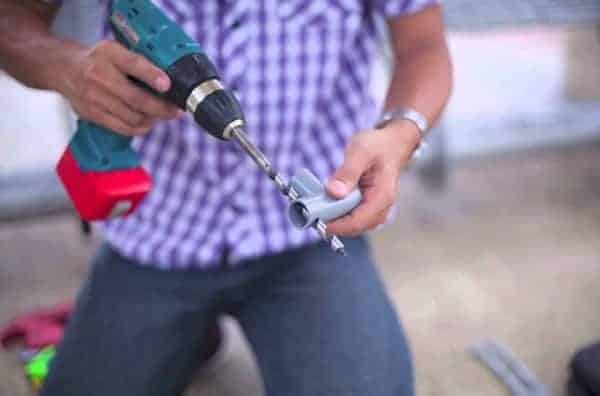
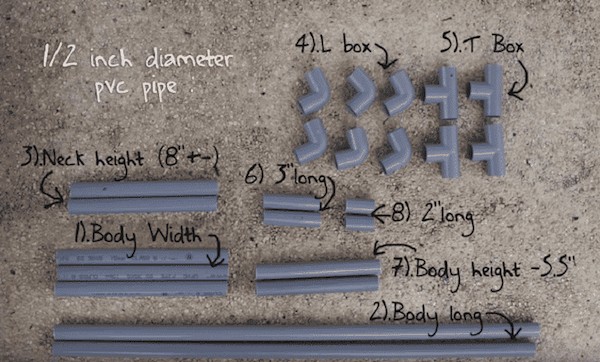
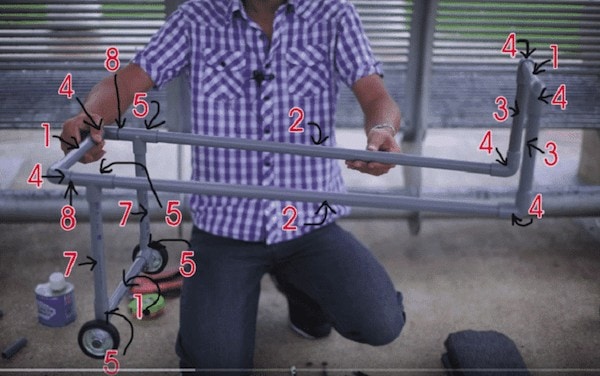
2. Sling-Style PVC Wheelchair by HandicappedPets.com
This is a simple, sling-style DIY dog wheelchair from Handicapped Pets that provides full-body support for dogs. These plans are tailored for small dogs, but there’s no reason you can’t upsize things to suit bigger pets.

The project looks quite easy to construct (although the sling may be a bit tricky for some), and it shouldn’t cost you very much either. However, the author does mention that the wheels can be difficult to find.
I really like this design, as it is not only extremely simple, but it provides full-body support. This means it may be a great option for dogs who have trouble with all four of their legs.
Skill Level: Easy to moderate (depending on your sewing ability)
Tools Required:
- Saw
- Scissors
- Measuring tape
- Pen
- Needle
Materials Needed:
- PVC pipe
- 4 PVC elbows
- PVC glue
- About 1 yard of fabric
- 4 PVC threaded caster wheels
- Thread
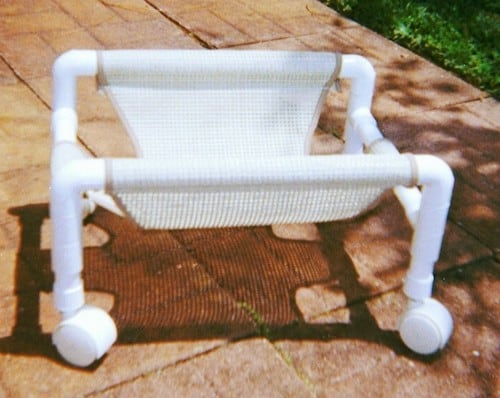
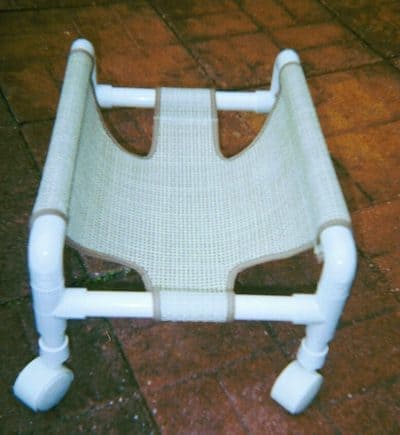
We couldn’t find a good video explaining how to build this type of wheelchair, but the frame is absurdly easy to put together – just look at the pictures and you should be able to figure it out.
The sling will require a bit more thought, as you’ll want to make sure that it is sewn well enough to support your dog and that it won’t chafe your pup’s legs.
3. Canine Wheelchair by TopDogTips.com
This is another resource that provides more of a conceptual explanation for building a DIY wheelchair for your dog than a specific set of plans, but Canine Wheelchair by TopDogTips.com does walk you through the process pretty thoroughly. It emphasizes experimentation, and it provides a few nifty ideas you may want to try.
Unfortunately, this resource doesn’t provide any photos of the wheelchair. So, you’ll have to let your imagination and intuition guide you through the process. They do provide a video, but it is the same video we included above with the first set of plans.
(You’ll need to scroll all the way down the page to get to the plans.)
Skill Level: Moderate
Tools Required:
- Saw to cut piping
- Pen
- Tape measure
Materials Needed:
- Piping (material dependent on dog weight and size)
- Assorted PVC connectors (including T connectors and elbows)
- Fabric to create a saddle
- Dog harness to help secure the wheelchair to your dog
- Wheels (size appropriate)
4. Super-Cheap DIY Dog Wheelchair from Reddit User WiFiEnabled
It probably shouldn’t be surprising that the “Front Page of the Internet” is a good source for DIY dog wheelchair plans, but what can I say? I was a bit surprised to find such a good set of plans on Reddit.
I think this Super-Cheap DIY Dog Wheelchair from Reddit is a pretty clever design, and it relies on two of the most flexible materials in the world: PVC pipe and duct tape.
I also like that the author used pretty big wheels when building the chair. Aside from the wheels, which may cost you a bit of money, this should be a very inexpensive wheelchair to build.
Skill Level: Easy to moderate
Tools Required:
- Saw
- Pen
- Measuring tape
- Scissors
Materials Needed:
- PVC pipe
- Assorted PVC connectors (including T connectors and elbows)
- PVC glue
- Duct tape
- Wheels
- Long threaded metal rod
Note that the author appears to have added some straps made from nylon webbing, but he doesn’t discuss this in the post. If you feel the need to add straps, you’ll also need a length of nylon webbing, as well as a needle and thread.
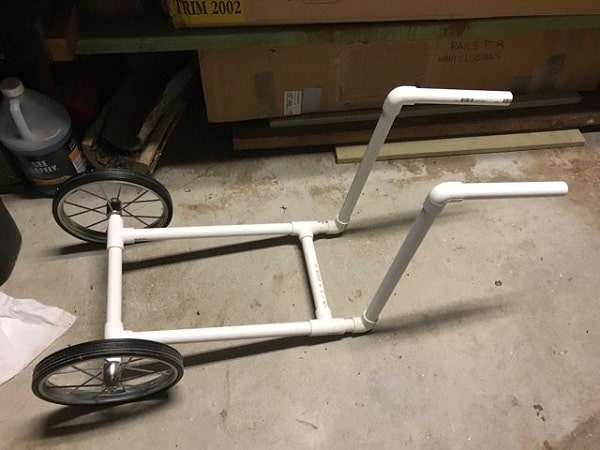
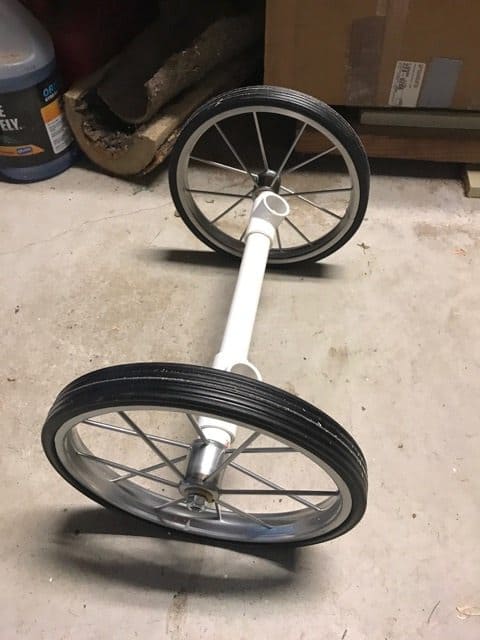
Here’s a video that the author credits with helping to inspire the wheelchair he made.
5. Aluminum Dog Wheelchair from Instructables
This Aluminum Dog Wheelchair from Instructables is one of the most professional-looking DIY wheelchairs we found. There’s no debating that it looks awesome, but that also means it is pretty tricky to construct. It’ll likely be beyond the skill set of the average dog owner.
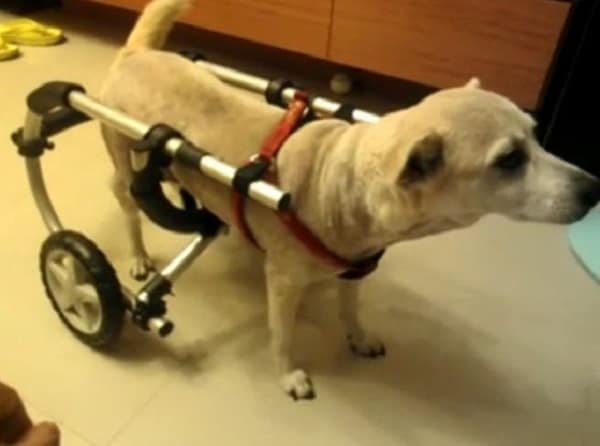
However, if you have the necessary tools, skill, and desire to give these plans a whirl, we’d love to see the final results! Be sure to share a link to your photos in the comments below.
Most of the DIY plans for dog wheelchairs rely on PVC pipe to build the frame. And while PVC is certainly a great material for these projects, aluminum tubing is probably even better, and that’s what these plans call for.
Note that (and I say this without any intended disrespect) it appears that English may not be the author’s first language, so you may have to rely heavily on the images and diagrams. It also means that I took a few liberties with the material list.
Skill Level: Very difficult
Tools Required:
- Cordless drill
- Aluminum tube-bending tools (see video below)
- Metal hacksaw (unless you purchase the tube precut)
- Measuring tape
- Pen
Materials Needed:
- 5 aluminum tubes
- 6 bike flashlight mounts
- Sponge tube
- Screws
- 2 wheels
- Aluminum tube plastic cap
- Velcro
- Sand or gravel (for bending the aluminum tubes)
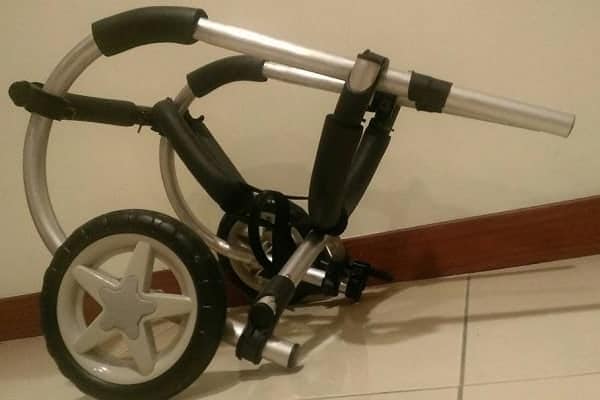
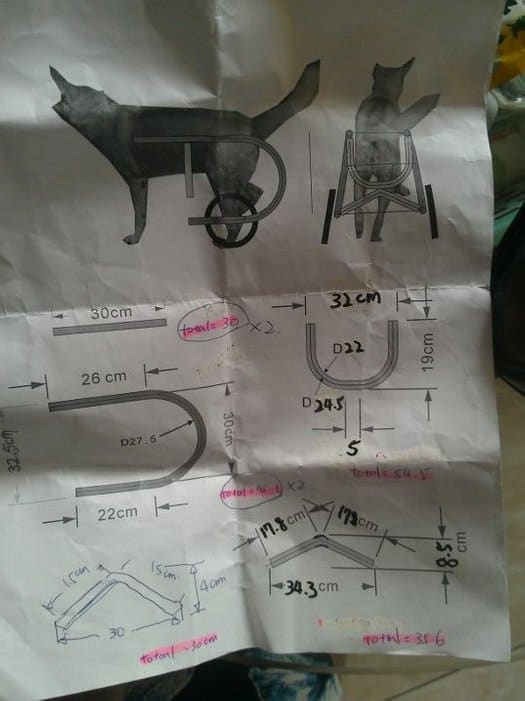
The author doesn’t provide a video explaining how to construct the chair, but, because we figure the average K9 of Mine reader isn’t familiar with aluminum tube bending techniques, we’ve included a quick tutorial video below.
6. 3D-Printed Canine Wheelchair by Makezine.com
Most of the plans for DIY wheelchairs rely on pretty low-tech solutions, but 3D-Printed Canine Wheelchair by Makezine.com plans are decidedly different as they incorporate 3D-printed components into the design.
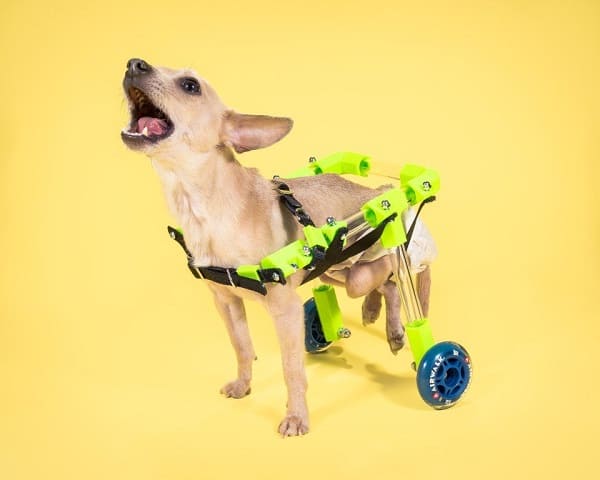
While most people don’t have access to 3D-printing technology today, that will likely change over the coming years as the technology becomes more affordable.
These plans also use acrylic tubing rather than PVC pipe, which makes the chair look fantastic.
Skill Level: Moderate, assuming you have access to a 3D printer
Tools Required:
- 3D printer
- Saw
- Measuring tape
- Pen
Materials Needed:
- Acrylic tubing
- Wheels (the ones used here appear to be rollerblade wheels)
- Plastic for the connectors
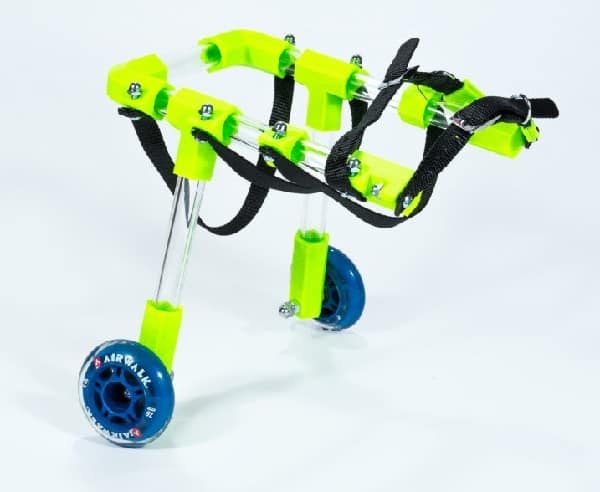
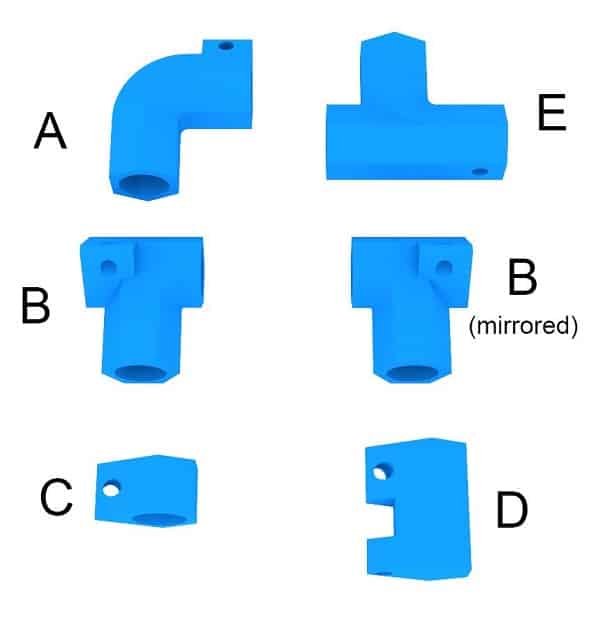
Unfortunately, we couldn’t find a video demonstrating how to put together this type of wheelchair, but I’m guessing that if you have a 3D printer, you can probably figure the rest out. The author does provide a handy little Google spreadsheet that’ll figure out the dimensions of the components for you.
7. Steel Tubing DIY Wheelchair
This Steel Tubing DIY Wheelchair from DoggyWheels.Blogspot is another set of plans that utilizes a metal frame, rather than one made from PVC or some other plastic.
A warning to sensitive types (like yours truly): The first image you’ll see on this site is the owner’s dog after she was put to sleep. It’s not a distasteful image or anything, but it certainly caught me by surprise. It’s potentially instant water-works stuff, so just be forewarned.
Nevertheless, the plans are quite awesome and the instructions are exhaustive, so it’s still worth checking out.
Now, if you will excuse me, I’m going to go hug my pup for a few hours and tell her how much I love her.
Skill Level: Moderate to difficult
Tools Required:
- Metal hacksaw
- Mallet
- Wax marker
- Needle
- Pen
- Measuring tape
- Steel tube bending equipment (see the plans for more information)
Materials Needed:
- 48-inch-long lengths of CR steel tube
- Large wheels
- Threaded cores
- Metal adhesive
- Threaded bolts
- Snap hook
- Pipe insulation
- Denim
- Velcro
- Thread
- Sand
We couldn’t find any videos demonstrating how to build this specific wheelchair, but we’ve included a steel-tube-bending instructional video below, which shows you how to use specialized hand tools to bend steel tubes.
8. PVC DIY Dog Wheelchair from ForContructionPros.com
This is a relatively straight-forward wheelchair design that uses PVC for the frame. PVC DIY Dog Wheelchair from ForContructionPros.com is similar to some of the other plans listed above (and the material list appears to have been inspired by some of the other plans, or vice-versa), but it doesn’t hurt to look at as many different plans and write-ups as possible.
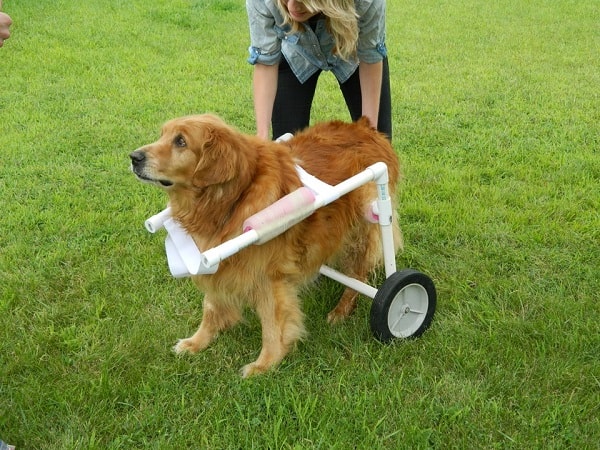
Note that this wheelchair was designed for a pretty big golden retriever, so it may be the perfect choice for big-dog owners.
Skill Level: Easy to moderate
Tools Required:
- Saw (the author uses a miter saw, but a handsaw would work)
- Measuring tape
- Pen
- Cordless drill
Materials Needed:
- 10-ft. of PVC pipe
- 4 PVC elbows
- 2 PVC standard Ts
- 2 furniture dolly wheels
- 1 wheel axle
- 2 C-clips
- Epoxy adhesive
- 1 pool noodle
- Ace bandages
- Elastic bands
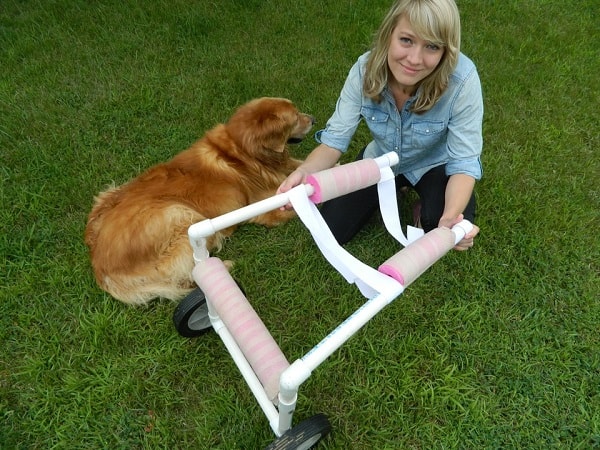
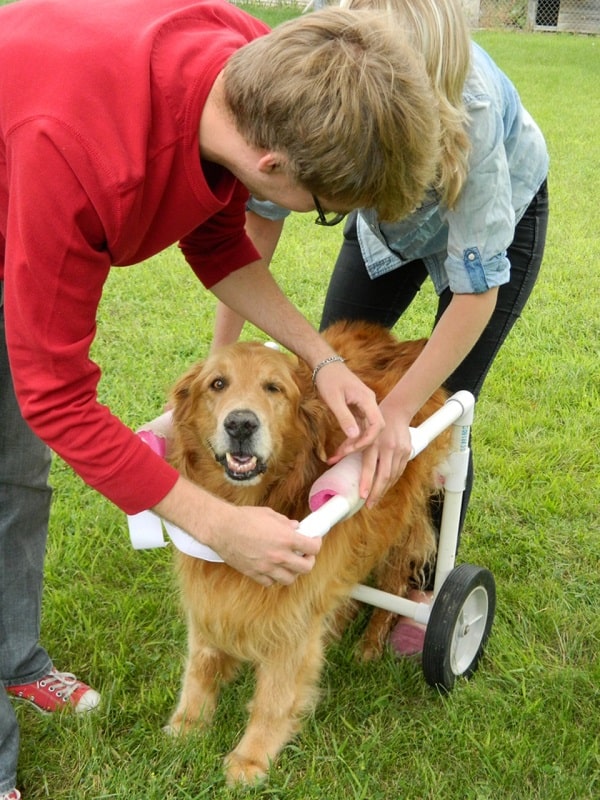
We couldn’t find a good video of this project, but it is pretty simple and the author provides decent instructions, so it shouldn’t be terribly difficult to build.
I ran into these two cuties and their humans at a local park a few weeks ago.
I didn’t want to hold them up too long, so I just explained my interest and snapped a few quick pics before we all went our separate ways.
Unfortunately, these two pups (Dante and Cheza) suffer from degenerative myelopathy — a progressive condition affecting the spinal cord that limits the mobility of afflicted four-footers.
Nevertheless, thanks to the hard work and ingenuity of their humans, Dante and Cheza seemed to get around pretty well and appeared to be having a great time exploring the park.
I just wanted to share these photos to give readers some additional ideas for building a DIY dog wheelchair.
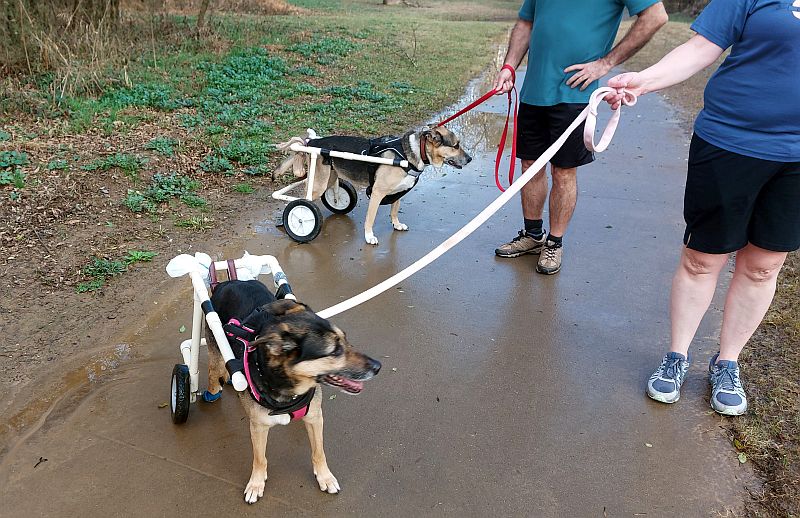
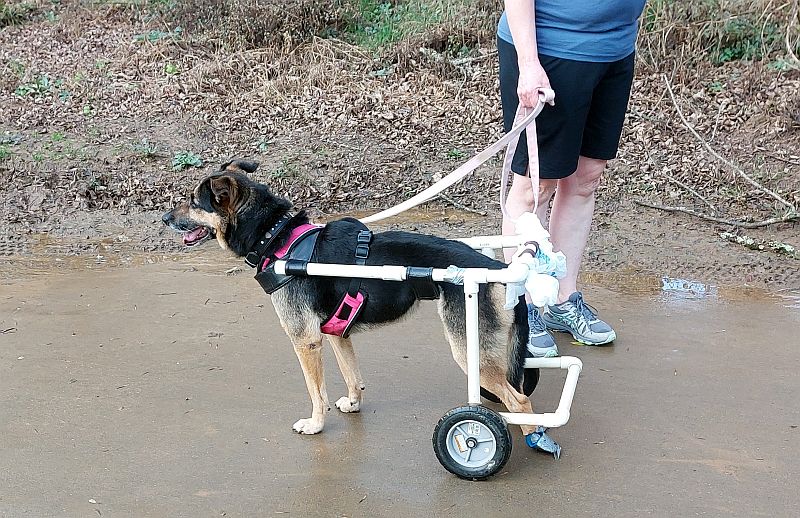
General Dog Wheelchair-Building Tips
No matter which of the plans listed above you decide to use (or if you just decide to wing it from scratch), you’ll want to keep a few general tips in mind when making your dog’s wheelchair.
- If you have the budget for it, purchase a PVC cutter instead of using a saw (or rent one). A normal handsaw will certainly slice through a PVC pipe, but a PVC cutter will do so more quickly and it’ll produce smoother edges too.
- You can use PVC glue if you want to, but it is probably not necessary. Most PVC pipes and couplings fit together tightly enough to stay put during normal use, and this will allow you to take the chair apart quickly when you need to travel. If you do use PVC glue, don’t apply it until you’ve assembled the chair and made sure everything works first.
- Finding good wheels is often one of the trickiest parts of the wheelchair-building process, so be creative. Often, you’ll find that the best way to obtain a good set of wheels (and an axle, if necessary) is by looking for a relatively inexpensive product that has wheels you could use. Consider skateboards, children’s toys, and garden tools.
- Keep the local climate in mind when you are picking out the material for the sling. If you live in a warm and muggy location, you may want to consider using a breathable or mesh-based fabric. Your pup will remain cooler if his skin is able to get some air.
- Cover any exposed hardware or sharp items on the chair. This is not only important for protecting your dog, but it will also help protect your furniture and walls from scrapes, dings, and scratches.
- If you are using casters for the wheels of your dog’s chair, consider making one of the four a locking caster. This will give you the option of immobilizing your dog, which may be handy from time to time.
- If you have trouble with the wheelchair tipping over, you can try to add a bit of weight to the bottom of the chair. You’ll have to be creative figuring out a way to do so, but you may want to try filling one of the PVC tubes with sand (be sure to seal the ends well). It shouldn’t take very much weight to help stabilize the chair a bit.
Teaching Your Dog to Use His Wheelchair
Unfortunately, many owners build or buy a wheelchair, strap their dog in, and then watch as their dog just sits there and refuses to move.
This is certainly frustrating, but there are a few things you can do to help your dog feel comfortable in his new chair and start pulling himself around.
Putting Your Dog in the Wheelchair
First, be sure to introduce your dog to the chair in a calm, reassuring manner. Just bring the wheelchair into the room and sit it in the middle of the floor. Let your dog go over and investigate it and give it a good sniffing (go sit by the wheelchair if he needs additional encouragement).
Once your dog has satisfied his curiosity and lost interest in the chair, pick him up and put him in it. Do so very slowly and be sure that he is resting comfortably. Lean back a bit and maintain a relaxed posture (he’ll take many of his cues from you). Let him adjust to the chair for a few minutes and then move on to the next step.
Be sure that you don’t remove your pup if he starts complaining and struggling to escape. Double check to make sure that nothing is causing him discomfort, but stay strong and keep him strapped in. Otherwise, you’re just teaching him that you’ll let him out if he complains.
It may take 15 minutes or so, but he’ll eventually quiet down and embrace his new ride.
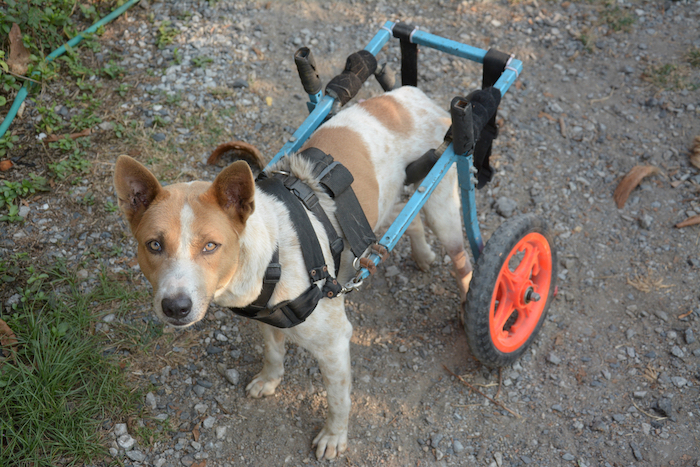
Getting Your Pup Used to the Wheelchair
Even if your dog sits in the chair without complaining, you may need to teach him how to scoot around – it may not be something he figures out intuitively.
The best way to do so is to just get up and walk into another room. Chances are, your pup will try to follow you by using his front legs. Once he learns that the wheels will carry the back half of his body, he’ll be well on his way to using the chair with ease.
However, some dogs won’t budge. They’ll just sit there stubbornly. In such cases, you’ll want to go grab a particularly tasty treat and try to bribe him into moving. You can also tie a bit of string to the front of the chair and pull him forward manually. This will likely cause him to start walking with his front legs, which will help him figure out the whole process.
Just keep trying – eventually, you should be able to convince your dog to use his chair.
Dog Wheelchair Alternatives for Immobile Canines
Wheelchairs aren’t the only way to help disabled or injured dogs get around. In fact, there are a number of alternatives that may help you transport your pet from place to place. Some of the most notable products include:
Alternative #1: Lift Harnesses
Even if you build your dog the finest DIY wheelchair possible, he’ll still need help getting up and down stairs. And while it may be easy to pick up an 8-pound Yorkie and carry him up the stairs, you don’t want to do this with a big dog.
Instead, you’ll want to use a lift harness or sling.
There are a number of different lift harnesses available, and different models are designed to help in different ways. For example, some harnesses are intended to provide support for the front or back of your dog’s body, while others are designed to provide total support for dogs who can’t use their front or back legs.
Just check out our lift harness buying guide to see some of the best options on the market.
Alternative #2: Backpacks
Backpack carriers are one of the best ways to help a mobility-impaired dog get around. Dogs usually love riding around on mom or dad’s back this way, and because you’ll be able to support your dog’s weight with your shoulders, chest, and back, it’s a pretty easy way to carry even moderately heavy dogs (although you probably won’t want to carry your Newfoundland or Great Dane this way).
There are dozens of different backpack carriers on the market, but we review nine of the best in our dog backpack buying guide, so go check ‘em out.
Alternative #3: Dog Purses / Slings
If your dog is pretty small, a carrying purse or sling may be a good option. Most carrying purses not only provide a great way to carry your dog, they’re fashionable and functional too.
Many of the best models also come with pockets for carrying treats and other things you may want to bring along.

We review a number of pup-carrying purses here, so be sure to check out the ones we think are best before you start shopping!
Alternative #4: Dog Strollers
If you like the idea of wheeling your dog around but don’t want to build him a wheelchair, you can always get him his own stroller.
Dog strollers are pretty similar to those used to push human babies around, but they have slightly different “cockpits,” which makes them comfortable for dogs to ride in. Many also feature screened canopies to prevent your pooch from jumping out.
We’ve reviewed some of the best dog strollers here, and at least one of them should suit your pup well.
Alternative #5: Repurposed Items
There are a million things you could use to help your dog get around better. None will work quite as well as a proper wheelchair, and you’ll likely have to make some modifications, but repurposing existing items is certainly something to consider.
For example, an old-fashioned wagon is just about perfect for wheeling your dog around the neighborhood or park. You could probably also use a wheelbarrow, although you’d have to lift your little fella up and put him inside, so it probably isn’t a great idea for tiny people with big dogs.
Just get creative – just about anything with wheels deserves consideration. A mechanic’s creeper (one of these things) with a rope tied to it may work, or you may be able to strap a milk crate to a hand truck.
And if there’s snow on the ground, you may not even need wheels at all – just commandeer your kid’s snow sled and drag your little four-footer around.
There’s a guy in my neighborhood that uses a child’s toy car to ferry his little chihuahuas around the neighborhood. I don’t know why he does – both dogs seem to get around just fine – but they certainly appear to enjoy being chauffeured by their dad. So, don’t forget to consider your kids’ toys if you are looking for something to help wheel around your pets!
***
Ultimately, it doesn’t matter what type of wheelchair you use for your dog. Whether you buy one from a retail outlet, construct your own from scratch, or get creative with something you find in the garage, the important thing is that you help your dog get around more easily so he doesn’t become depressed or frustrated.
Just consider the DIY solutions above and try to pick the best one for your pet’s needs and your skill level.
Have you ever made a DIY dog wheelchair? Share your own tips and tricks in the comments!
Want more DIY projects for your pooch? Check out our guides on:
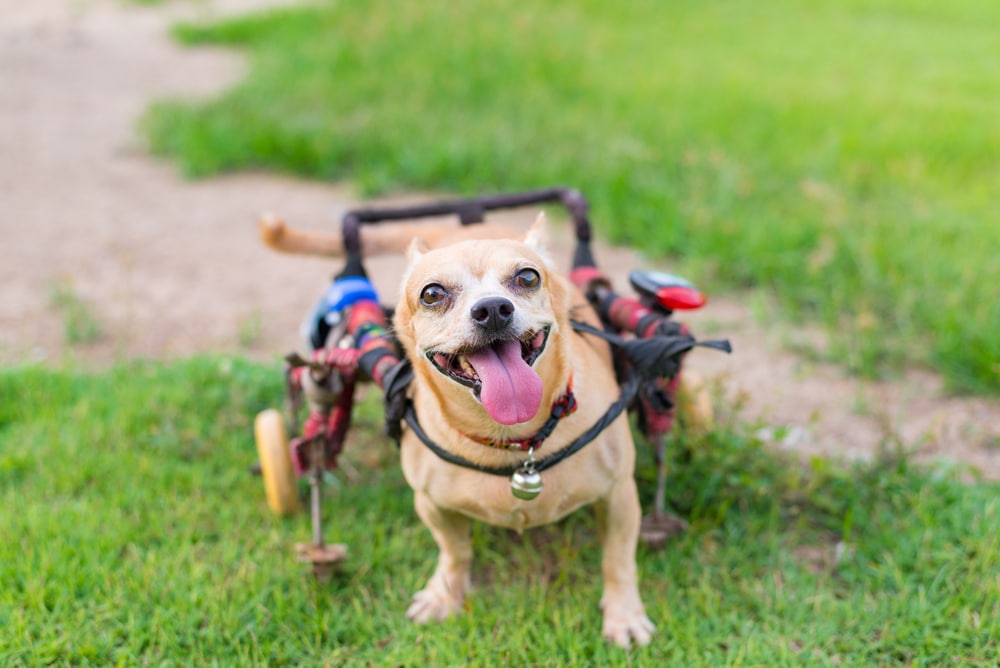
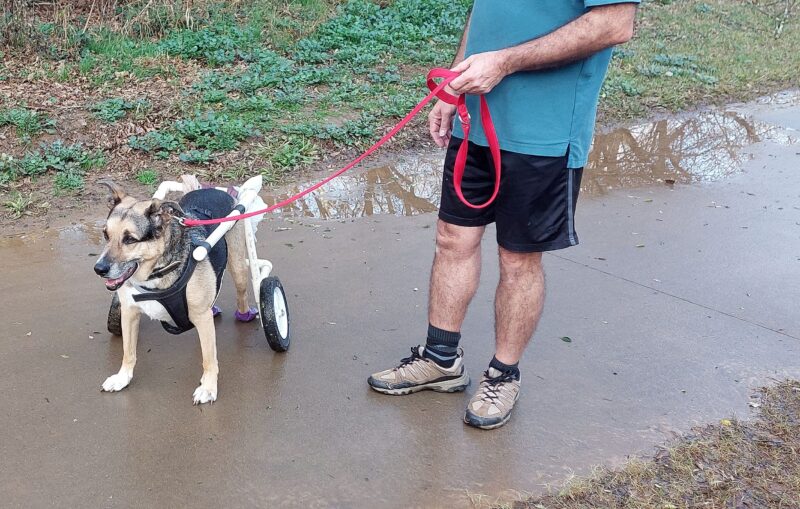

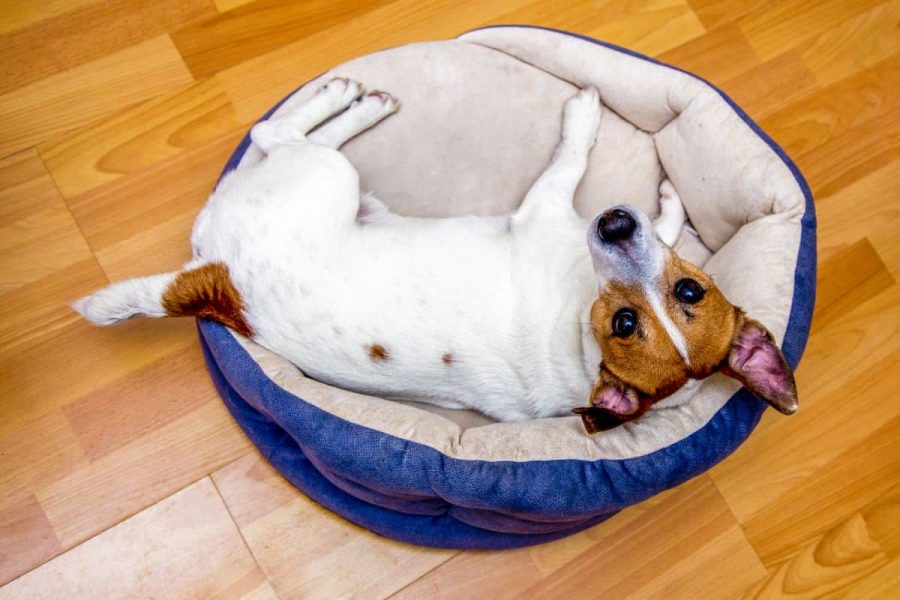










Leave a Comment